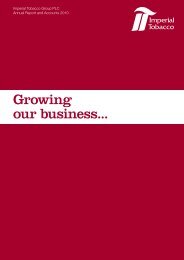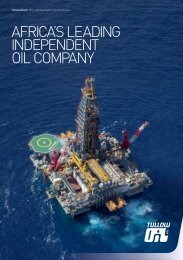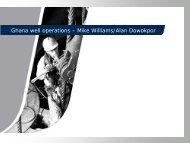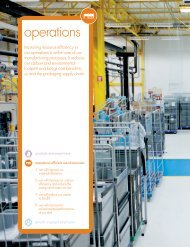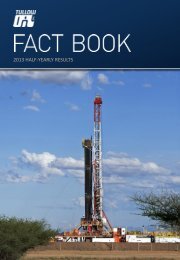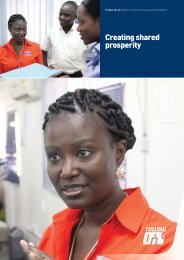Tullow Oil plc 2011/2012 Corporate Responsibility Report - The Group
Tullow Oil plc 2011/2012 Corporate Responsibility Report - The Group
Tullow Oil plc 2011/2012 Corporate Responsibility Report - The Group
- No tags were found...
Create successful ePaper yourself
Turn your PDF publications into a flip-book with our unique Google optimized e-Paper software.
EHS risk management and asset protectionIn <strong>2011</strong>, a new <strong>Group</strong> Asset Protection Manager was appointed.Crisis management, emergency preparedness and security arecritical EHS risk and reputation management issues for <strong>Tullow</strong>.We consider all forms of EHS risk, from major accidents tosimple workplace hazards. We maintain a dynamic EHS riskinventory that sets out our top 10 EHS risks which are alsoranked by significance. This enables us to take a strategicapproach to EHS risk management. <strong>Tullow</strong>’s Chief OperatingOfficer gives an EHS update at each Board meeting. EHS risksand statistics are reported monthly and there is a quarterlyreview process with participation from <strong>Tullow</strong> operations,regional business management, corporate EHS and Executives.Twice a year the Board receives a detailed update on EHSissues and risks. In <strong>2012</strong>, we introduced a <strong>Group</strong> SecurityStandard. <strong>Tullow</strong> has interests in 22 countries, each presentinga different operating and security risk profile. <strong>The</strong> introductionof this standard reinforces our requirement to safeguard peopleand property against potential security threats and ensures acommon base level of security is maintained wherever weoperate. To complement this, <strong>Tullow</strong> has requested admissionto the Voluntary Principles on Security and Human Rights.<strong>The</strong>se are a set of principles to guide companies in maintainingthe safety and security of their operations, within a clearoperating structure that promotes respect for human rights.More informationPage<strong>Corporate</strong> risk framework 14toes 63Think Forward in <strong>2012</strong> and beyondIt is a real challenge to consistently deliver top quartile EHSperformance, in the context of our increased scale of activitiesand the rapid growth in our employees, contractors and areasof operation. As <strong>Tullow</strong> grows there is potential for moreincidents but there is also a danger of falling into the positionthat more procedures are needed to prevent these. In adynamic operating environment people need to be empoweredto think beyond systems and checkboxes. <strong>The</strong>y need to be ableto adapt to change, sometimes very rapidly, and be ready tointervene, respond and act. <strong>The</strong> whole purpose of ‘ThinkForward’, which is our new EHS framework, is to get peopleto look ahead and be proactive in preventing an incident byactively thinking about the risks that they are managing.With good collaboration, strong leadership and up-to-datecompetencies our aim is to build a culture of confidentinterventions. ‘Think Forward’ will help us create the rightbehaviours which will enable us to manage EHS in a muchmore responsive and tailored way. It is about improving our EHSperformance but, more importantly, it is about enabling people.3MEASURING OUR PERFORMANCESETTING EMISSIONS TARGETS<strong>Tullow</strong>’s operational footprint has grown extensivelyin the last five years. <strong>The</strong> <strong>Group</strong> has discovered fournew oil basins, three in Africa and one offshoreFrench Guiana in South America. We becameoperator of a major new production facility offshoreGhana, which is expected to achieve plateauproduction in 2013. We also have a number of majordevelopment projects underway in Ghana andUganda. In the meantime, we continue to review ourportfolio of assets and have disposed of gasproduction facilities in the UK, with plans to disposeof our Asian portfolio in the near future. In addition,we have sought to significantly improve ourenvironmental data monitoring and reporting andthis year we adopted industry standards.Indicative of the scale and pace of change is thegrowth in the number of hours worked across<strong>Tullow</strong> activities. In <strong>2011</strong>, over 13 million hours wereworked across <strong>Tullow</strong>, including a 35% increase inproduction, 35 E&A wells and 60 development wells.This compares with 5.6 million hours worked justfive years ago. Our <strong>2011</strong> activities included asignificant number of higher risk operations such asdeepwater drilling in South America and productionramp-up in Ghana with 33 oil liftings to date.This level of change across our activities makes itvery difficult to set emission reduction targets forthe <strong>Group</strong>. However, we believe our <strong>2011</strong>environmental performance is the penultimate stepbefore a predicted improvement across a range ofenvironmental indicators including greenhouse gasemissions, water use, waste and spills. Thisimproved performance should be achieved boththrough the launch of toes in March <strong>2012</strong> coupledwith the changes made to <strong>Group</strong>-wide <strong>2012</strong>environmental KPIs.In <strong>2012</strong>, a toes self-assessment tool has beendeveloped and is expected to be completed foroperated and ownership controlled assets this year.Environmental and Social Management Plan (ESMP)closure reports are required for each Environmentaland Social Impact Assessment (ESIA). <strong>The</strong>se,together with implementation of the <strong>Tullow</strong>Chemical Management Plan, Drilling Fluids andCuttings Disposal Standard and Greenhouse GasStandard, underpin the expected improvement inour environmental performance. <strong>The</strong>se activities willalso provide us with clear identification of the gapswe need to work on in 2013 and 2014.67www.tullowoil.com



